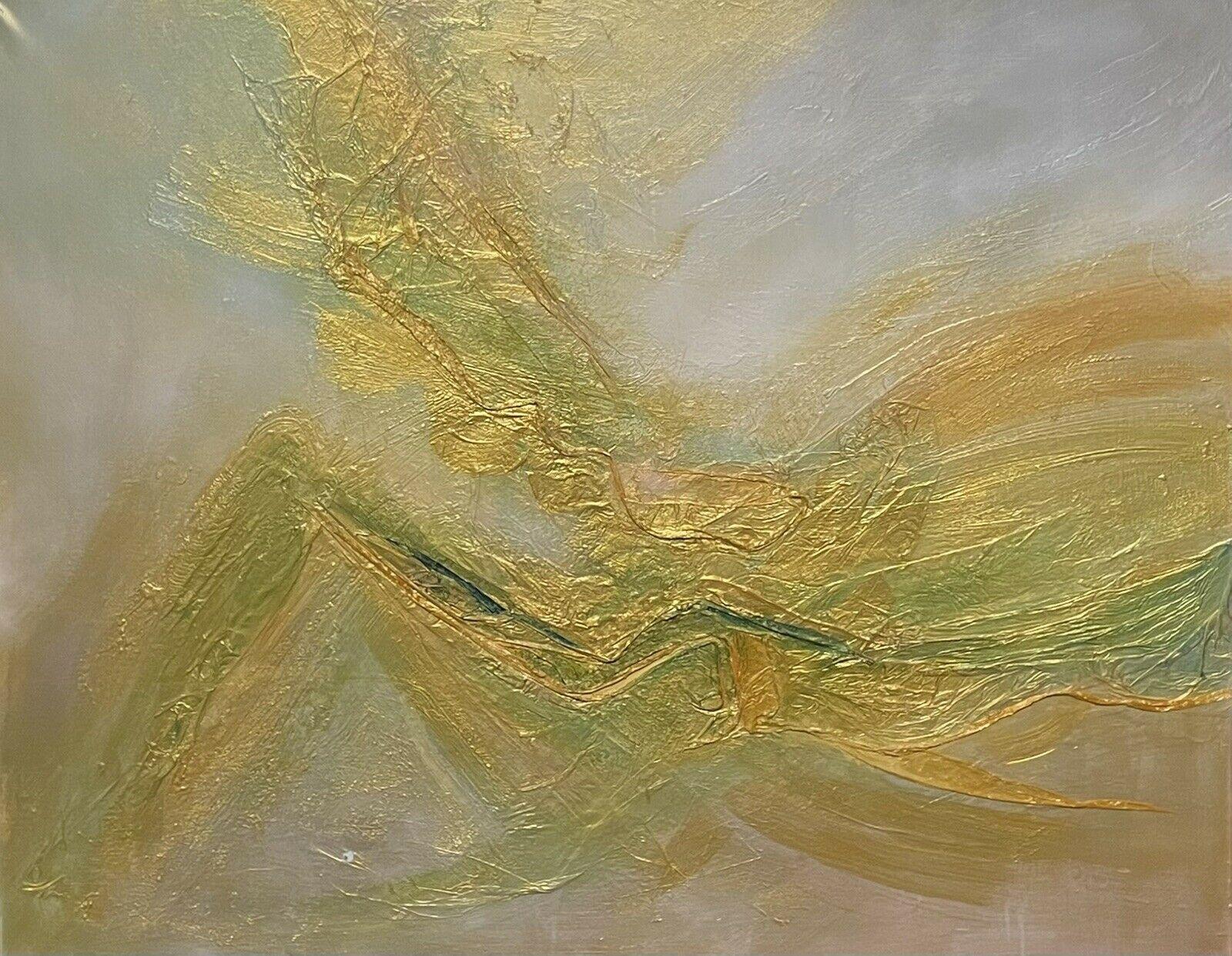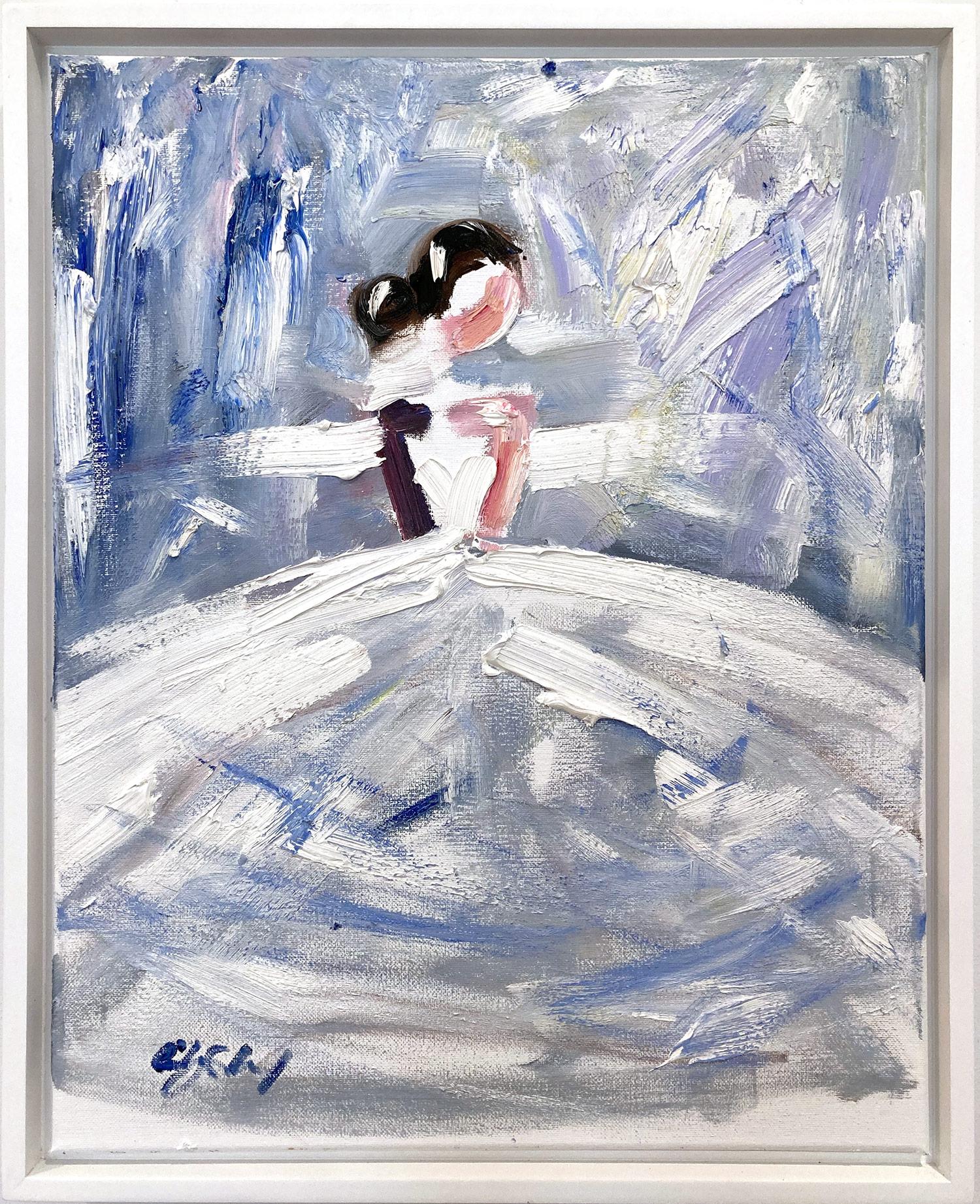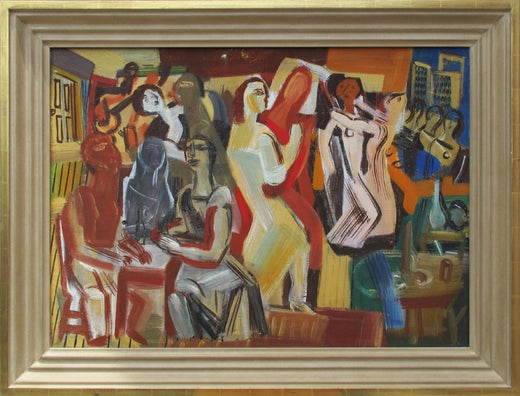Vaclav Vytlacil"The Evening Crowd, Manhattan"c. 1932
c. 1932
About the Item
- Creator:Vaclav Vytlacil (1892-1984, American)
- Creation Year:c. 1932
- Dimensions:Height: 29 in (73.66 cm)Width: 33 in (83.82 cm)Depth: 3 in (7.62 cm)
- More Editions & Sizes:Framed Size 28" x 32"Price: $48,125
- Medium:
- Movement & Style:
- Period:
- Condition:
- Gallery Location:Lambertville, NJ
- Reference Number:
Vaclav Vytlacil
Born in 1892, Vaclav Vytlacil was a highly educated and gifted artist, early at the School of the Art Institute of Chicago, and later at the Art Students League. In the 1920s, his travels to Europe and studies of the old masters helped him gain artistic perspective and knowledge. At the Royal Academy of Art in Munich, Vytlacil met and befriended Hans Hofmann, becoming his teaching assistant. After returning to the US in 1928, Vytlacil became a member of the Art Students League faculty and successfully persuaded Hofmann to teach at the League as well. In 1936, he became a co-founder of the American Abstract Artists group and taught at Queens College in New York; the College of Arts and Crafts in Oakland, California; Black Mountain College in North Carolina; and the Art Students League. Vytlacil was honored with solo shows at The Carnegie Institute, Montclair Art Museum, the Phillips Memorial Gallery, the Krasner Gallery, University of Notre Dame, Rochester Art Gallery and others.
- ShippingRetrieving quote...Ships From: Lambertville, NJ
- Return PolicyThis item cannot be returned.
- "Manhattan Night Life"By Vaclav VytlacilLocated in Lambertville, NJJim’s of Lambertville is proud to offer this artwork by: Vaclav Vytlacil (1892-1984) He was born to Czechoslovakian parents in 1892 in New York City. Living in Chicago as a youth, he took classes at the School of the Art Institute of Chicago, returning to New York when he was 20. From 1913 to 1916, he enjoyed a scholarship from the Art Students League, and worked with John C. Johansen (a portraitist whose expressive style resembled that of John Singer Sargent), and Anders Zorn. He accepted a teaching position at the Minneapolis School of Art in 1916, remaining there until 1921. This enabled him to travel to Europe to study Cézanne’s paintings and works of the Old Masters. He traveled to Paris, Prague, Dresden, Berlin, and Munich seeking the works of Titian, Cranach, Rembrandt, Veronese, and Holbein, which gave him new perspective. Vytlacil studied at the Royal Academy of Art in Munich, settling there in 1921. Fellow students were Ernest Thurn and Worth Ryder, who introduced him to famous abstractionist Hans Hofmann. He worked with Hofmann from about 1922 to 1926, as a student and teaching assistant. During the summer of 1928, after returning to the United States, Vytlacil gave lectures at the University of California, Berkeley, on modern European art. Soon thereafter, he became a member of the Art Students League faculty. After one year, he returned to Europe and successfully persuaded Hofmann to teach at the League as well. He spent about six years in Europe, studying the works of Matisse, Picasso, and Dufy. In 1935, he returned to New York and became a co-founder of the American Abstract Artists group in 1936. He later had teaching posts at Queens College in New York; the College of Arts and Crafts in Oakland, California; Black Mountain College in North Carolina; and the Art Students League. His paintings exhibit a clear inclination toward modernism. His still lives and interiors from the 1920s indicate an understanding of the art of Cézanne. In the 1930s, his works displayed two very different kinds of art at the same time. His cityscapes and landscapes combine Cubist-inspired spatial concerns with an expressionistic approach to line and color. Vytlacil also used old wood, metal, cork, and string in constructions, influenced by his friend and former student, Rupert Turnbull. He eventually ceased creating constructions as he considered them too limiting. The spatial challenges of painting were still his preference. During the 1940s and 1950s, his works indicated a sense of spontaneity not felt in his earlier work. He married Elizabeth Foster in Florence, Italy, in 1927 and they lived and worked in Positano, Italy for extended periods of time. Later on, they divided their time between homes in Sparkill, New York and Chilmark, Massachusetts, where Vyt, as he was affectionately called, taught at the Martha's Vineyard Art...Category
1930s Abstract Expressionist Abstract Paintings
MaterialsCanvas, Oil
- "Seriously!"By James LechayLocated in Lambertville, NJSigned lower right Jim’s of Lambertville is proud to offer this artwork by: Rex Ashlock (1918 – 1999) Born in Spokane, Washington in 1918 Rex Ashlock was known for his abstract, f...Category
20th Century Abstract Abstract Paintings
MaterialsCanvas, Oil
- "After Work"By Vaclav VytlacilLocated in Lambertville, NJJim’s of Lambertville is proud to offer this artwork. Signed lower right Vaclav Vytlacil (1892-1984) He was born to Czechoslovakian parents in 1892 in New York City. Living in C...Category
20th Century Abstract Expressionist Abstract Paintings
MaterialsOil, Board
- “Woman on the Rocks”By Josef ZenkLocated in Lambertville, NJJim’s of Lambertville is proud to offer this artwork by: Josef Zenk (1904-2000) Josef Zenk was born in New York City in 1904. After graduating from high school, he studied for thre...Category
20th Century Abstract Figurative Paintings
MaterialsOil, Board
- “Woman in Black”By Vaclav VytlacilLocated in Lambertville, NJJim’s of Lambertville is proud to offer this artwork by: Vaclav Vytlacil (1892-1984) He was born to Czechoslovakian parents in 1892 in New York City. Living in Chicago as a youth, he took classes at the School of the Art Institute of Chicago, returning to New York when he was 20. From 1913 to 1916, he enjoyed a scholarship from the Art Students League, and worked with John C. Johansen (a portraitist whose expressive style resembled that of John Singer Sargent), and Anders Zorn. He accepted a teaching position at the Minneapolis School of Art in 1916, remaining there until 1921. This enabled him to travel to Europe to study Cézanne’s paintings and works of the Old Masters. He traveled to Paris, Prague, Dresden, Berlin, and Munich seeking the works of Titian, Cranach, Rembrandt, Veronese, and Holbein, which gave him new perspective. Vytlacil studied at the Royal Academy of Art in Munich, settling there in 1921. Fellow students were Ernest Thurn and Worth Ryder, who introduced him to famous abstractionist Hans Hofmann. He worked with Hofmann from about 1922 to 1926, as a student and teaching assistant. During the summer of 1928, after returning to the United States, Vytlacil gave lectures at the University of California, Berkeley, on modern European art. Soon thereafter, he became a member of the Art Students League faculty. After one year, he returned to Europe and successfully persuaded Hofmann to teach at the League as well. He spent about six years in Europe, studying the works of Matisse, Picasso, and Dufy. In 1935, he returned to New York and became a co-founder of the American Abstract Artists group in 1936. He later had teaching posts at Queens College in New York; the College of Arts and Crafts in Oakland, California; Black Mountain College in North Carolina; and the Art Students League. His paintings exhibit a clear inclination toward modernism. His still lives and interiors from the 1920s indicate an understanding of the art of Cézanne. In the 1930s, his works displayed two very different kinds of art at the same time. His cityscapes and landscapes combine Cubist-inspired spatial concerns with an expressionistic approach to line and color. Vytlacil also used old wood, metal, cork, and string in constructions, influenced by his friend and former student, Rupert Turnbull. He eventually ceased creating constructions as he considered them too limiting. The spatial challenges of painting were still his preference. During the 1940s and 1950s, his works indicated a sense of spontaneity not felt in his earlier work. He married Elizabeth Foster in Florence, Italy, in 1927 and they lived and worked in Positano, Italy for extended periods of time. Later on, they divided their time between homes in Sparkill, New York and Chilmark, Massachusetts, where Vyt, as he was affectionately called, taught at the Martha's Vineyard Art...Category
1960s Abstract Expressionist Figurative Paintings
MaterialsOil, Board
- "Roman Bath" Series (2/3)By Vaclav VytlacilLocated in Lambertville, NJJim’s of Lambertville is proud to offer this artwork by: Vaclav Vytlacil (1892-1984) He was born to Czechoslovakian parents in 1892 in New York City. Living in Chicago as a youth, he took classes at the School of the Art Institute of Chicago, returning to New York when he was 20. From 1913 to 1916, he enjoyed a scholarship from the Art Students League, and worked with John C. Johansen (a portraitist whose expressive style resembled that of John Singer Sargent), and Anders Zorn. He accepted a teaching position at the Minneapolis School of Art in 1916, remaining there until 1921. This enabled him to travel to Europe to study Cézanne’s paintings and works of the Old Masters. He traveled to Paris, Prague, Dresden, Berlin, and Munich seeking the works of Titian, Cranach, Rembrandt, Veronese, and Holbein, which gave him new perspective. Vytlacil studied at the Royal Academy of Art in Munich, settling there in 1921. Fellow students were Ernest Thurn and Worth Ryder, who introduced him to famous abstractionist Hans Hofmann. He worked with Hofmann from about 1922 to 1926, as a student and teaching assistant. During the summer of 1928, after returning to the United States, Vytlacil gave lectures at the University of California, Berkeley, on modern European art. Soon thereafter, he became a member of the Art Students League faculty. After one year, he returned to Europe and successfully persuaded Hofmann to teach at the League as well. He spent about six years in Europe, studying the works of Matisse, Picasso, and Dufy. In 1935, he returned to New York and became a co-founder of the American Abstract Artists group in 1936. He later had teaching posts at Queens College in New York; the College of Arts and Crafts in Oakland, California; Black Mountain College in North Carolina; and the Art Students League. His paintings exhibit a clear inclination toward modernism. His still lives and interiors from the 1920s indicate an understanding of the art of Cézanne. In the 1930s, his works displayed two very different kinds of art at the same time. His cityscapes and landscapes combine Cubist-inspired spatial concerns with an expressionistic approach to line and color. Vytlacil also used old wood, metal, cork, and string in constructions, influenced by his friend and former student, Rupert Turnbull. He eventually ceased creating constructions as he considered them too limiting. The spatial challenges of painting were still his preference. During the 1940s and 1950s, his works indicated a sense of spontaneity not felt in his earlier work. He married Elizabeth Foster in Florence, Italy, in 1927 and they lived and worked in Positano, Italy for extended periods of time. Later on, they divided their time between homes in Sparkill, New York and Chilmark, Massachusetts, where Vyt, as he was affectionately called, taught at the Martha's Vineyard Art...Category
20th Century Abstract Impressionist Abstract Paintings
MaterialsOil, Board
- "The Power (People)" 1970 Olaf KarlsenLocated in SANTA FE, NM"The Power (People)" 1970 Olaf Karlsen (b. 1947) Oil on canvas Signed front and back. 28 1/4 x 40 inches (frame) Olaf Karlsen has managed to remain a m...Category
1970s Abstract Abstract Paintings
MaterialsCanvas, Oil
- Rising TideBy Tom LieberLocated in Miami, FLTom Lieber is known for his dynamic abstract expressionist paintings, which focus on the human energy, experience, feelings, and processes of receiving and expressing. Lieber uses his powerful intuition to project the state of his inner being onto the canvas, enriching the paintings with strong emotions. Influenced by nature and meditations, Lieber believes that the body can be better equipped for creating than the mind, treating the act of painting as a full body experience with his spontaneous gestures and fearless approach to the canvas. The grace and shape of his bold lines appear over subtle neutral backgrounds with pockets of dense color and movement. His artworks are included in many prominent private and public art collections, including Solomon R. Guggenheim Museum, New York, Metropolitan Museum of Art, New York, Museum of Modern Art San Francisco (SFMoMA), San Francisco, Tate Modern, London, Oakland Museum of California, Oakland, Crocker Art Museum, Sacramento, and Museum of Contemporary Art Los...Category
2010s Abstract Abstract Paintings
MaterialsCanvas, Oil
- For a walk. Oil on loose canvas, 45 x 42 cmLocated in Riga, LVFor a walk. Oil on loose canvas, 45 x 42 cm Victor Karnauh (1950, Dnepropetrovsk Oblast, Ukrainian SSR – 2012, Dnepropetrovsk Oblast, Ukraine) – a painter, a monument designer, grad...Category
1990s Abstract Figurative Paintings
MaterialsCanvas, Oil
- French Contemporary Abstract Painting Gold Highlights Expressionist CompositionLocated in Cirencester, GloucestershireArtist/ School: French expressionist/ abstract contemporary artist, 21st century Title: Abstract composition Medium: oil/mixed media painting on canvas, unframed. canvas: 25.75...Category
21st Century and Contemporary Abstract Expressionist Abstract Paintings
MaterialsOil, Canvas, Mixed Media
- THE ARCHER - Italian Abstract Oil on Canvas Painting.By Alfonso PragliolaLocated in Napoli, ITThe archer - Modern -Alfonso Pragliola Italia 2014 - Oil on canvas cm.60x40. Black laquered wooden frame.Category
2010s Abstract Abstract Paintings
MaterialsCanvas, Oil
- "Parisian Mornings" Figure Chanel French Haute Couture Oil Painting on CanvasBy Cindy ShaoulLocated in New York, NYExploring the purity of the feminine form and the drama of French haute couture, artist Cindy Shaoul creates a dialogue between the figurative and the abstract. Her spirited composit...Category
2010s Abstract Figurative Paintings
MaterialsCanvas, Oil




